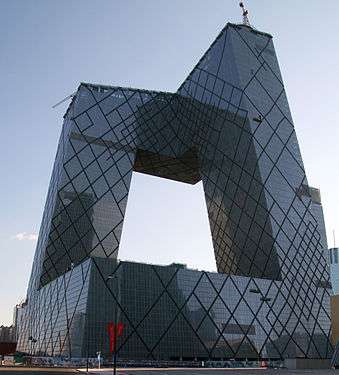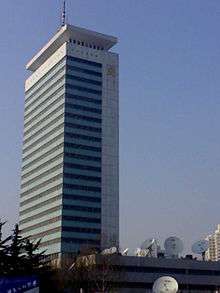China Central Television
 | |
 | |
| Country | China |
|---|---|
First air date | 2 September 1958 |
| Headquarters | CCTV Headquarters, Beijing |
Broadcast area | Worldwide |
| Owner | China Media Group |
Launch date | 1 May 1978 |
Former names | Beijing Television |
| 25 | |
| 19 | |
| Callsigns | Voice of China (external) |
| Affiliation | China Global Television Network |
Official website |
www |
| China Central Television | |||||||||||||
| Simplified Chinese | 中国中央电视台 | ||||||||||||
|---|---|---|---|---|---|---|---|---|---|---|---|---|---|
| Traditional Chinese | 中國中央電視臺 or 中國中央電視台 | ||||||||||||
| Literal meaning | China Central Television Station | ||||||||||||
| |||||||||||||
| Chinese abbreviation | |||||||||||||
| Simplified Chinese | 央视 | ||||||||||||
| Traditional Chinese | 央視 | ||||||||||||
| Literal meaning | Central-Vision | ||||||||||||
| |||||||||||||
China Central Television (CCTV, formerly Beijing Television), is the predominant state television broadcaster in the People's Republic of China. CCTV has a network of 50 channels broadcasting different programmes and is accessible to more than one billion viewers.[1] As of present, there are 50 television channels, and the broadcaster provides programming in six different languages. Most of its programmes are a mixture of news, documentary, social education, comedy, entertainment, and drama, the majority of which consists of Chinese soap operas and entertainment.[2]
CCTV is one of the official mouthpieces of the Communist Party of China, and is part of what is known in China as the "central three" (中央三台), with the others being China National Radio and China Radio International.
History
CCTV (中央电视台) broadcast its first program on 2 September 1958. Due to increasing demands, it soon launched its second channel in 1963 and third channel in 1969, followed by the first simultaneous satellite broadcasts nationwide in 1972. Starting from 1 May 1973, Peking Television began broadcasting experimentally in color on its second channel every Tuesday, Thursday, and Saturday using the PAL-D system, and fully converted to color broadcasting by 1977. The network changed its name to CCTV on 1 May 1978.[3]
Until the late 1970s, CCTV held only evening broadcasts, usually closing down at midnight. During the summer and winter academic vacations, it occasionally transmitted daytime programming for students. In 1980 CCTV experimented with news relays from local and central television studios via microwave.[4] By 1985, CCTV had already become a leading television network in China. In 1987 CCTV's popularity soared due to the adaptation and presentation of Dream of the Red Chamber. The 36-episode TV series—the first Chinese television drama to enter the global market—[5] still remains popular in the international market. In the same year, CCTV exported 10,216 programmes to 77 foreign television stations.[5]
Initially, the Publicity Department of the Communist Party of China Central Committee issued directive censorship of programs. During reform in the 1990s, the Party adopted new standards for CCTV, "affordability" and "acceptability", loosening the previous government control.[6] Affordability refers to purchasing ability of programs, while acceptability requires that a programme has acceptable content, preventing broadcasts of material that contains inappropriate content or holds against the Communist Party of China.[7]
On 2 September 2008 the new CCTV Headquarters was opened on the occasion of the 50th anniversary of CCTV.
In July 2009 CCTV expanded its coverage and target audience by launching CCTV-العربية, its international channel in Arabic language.[8]
Today, CCTV has 24 channels, most of them airing 24 hours a day. On 17 June 2013, CCTV announced General channel, News channel, and other 24 public channels starting broadcast on the new site of CCTV.[9]
On 31 December 2016, China Central Television's foreign services were spun off into China Global Television Network (CGTN) .
Organization
China Central Television falls under the supervision of the State Administration of Radio, Film, and Television which is in turn subordinate to the State Council of the People's Republic of China. A Vice Minister of the state council serves as chairman of CCTV. The organisation has relationships with regional television stations run by local governments, which must reserve up to two channels for the national broadcaster.[10]
The organization is considered one of the "big three" media outlets in China, along with the People's Daily and Xinhua.[11]
Management
The current president of CCTV is Shen Haixiong, who was appointed in February 2018.[12]
China Network Television
China Network Television (CNTV) is an internet-based broadcaster of China Central Television which launched on 28 December 2009. CNTV offers six foreign languages services, including English, French, Spanish, Russian, Korean, and Arabic.
Logo

 1998–1June 2013 (CCTV-13), 31Dec2015(others)
1998–1June 2013 (CCTV-13), 31Dec2015(others) Current logo, adopted in 2013 (extended to other stations in 2015)
Current logo, adopted in 2013 (extended to other stations in 2015)
From 1979 to 2001, the CCTV logo consisted of two crossing ellipses, and was designed by Zhang Desheng (张德生), a former CCTV employee. It was commonly called "蝴蝶标" (lit. butterfly logo) in Chinese. The logo resembled the course or shape of a satellite, atomic nucleus and antenna. The animation starts as the blue background with stars, 2 stars moving create a logo and cause to collide forming a logo and the "TV" text as the sonic waves movimg as the logo fading to blue and the text Zhongyang Dianshi Tai appears as the Chinese text also appears. There is a Chinese temple underneath. The music was composed by the Chinese orchestra. It used three primary colors (red, green and blue). Later in 1989, the logo was redone in CGI after update Xinwen Lianbo. The logo ceased to be used in 1998 due to a copyright dispute (mostly used the color e.g. ABS-CBN) and retired changing the new logo. After this period, this logo could be seen on reporters' microphones. The logo is not currently used.
The new logo of CCTV was introduced in 2013 as part of the corporate rebrand of its logos and on-air identity. It started as the current logo for CCTV-13 until it was adopted by the rest of the network in 2015-16. The 1998 logo, through, remains in force as a secondary logo.
Logo on-screen
- 2 September 1958 – 30 April 1978: No logo whatsoever, only used "北京电视台" (translated to "Beijing Television", written by Mao Zedong) at the end of programs.[16]
- 1 May 1978 – 30 September 1991: CCTV used the caption logo "中央电视台" on the bottom left corner of the screen (the logo appeared on :00 and :30 only).[17]
- Since 1 October 1991, CCTV uses caption logo "CCTV" on the top left corner of the screen.[18]
- Since 1 March 1992, The "butterfly logo" was used on the lower left corner of the screen (the logo appeared at :00 and :30 of the hour only).[19] The logo is used during all times on top left corner since September 1992.[20] In 1995, the logo has been modified, due to the launch of CCTV-3, CCTV-5, CCTV-6, CCTV-7 and CCTV-8.
- Since 1 June 1998, CCTV uses the transparent logo (used on-screen only) on top left corner, the disk-shaped timekeeping device was introduced. It is the symbol of CCTV currently and the disk-shaped timekeeping device (digital clock superimposed on a transparent disk) is shown on top right corner.
- Since 8 July 2001, CCTV uses the current logo for bids for the 2008 Summer Olympics.[21] The logo has been modified on 12 August 2001 due to difficulty to identify the channel's number.
- On 21 September 2009, CCTV-2 changed the logo, added the four Chinese characters "财经频道" (Business Channel) under the logo.
- On 1 January 2011, CCTV modified all its channels' logos, adding the channel name under the logos. Also, CCTV News, CCTV Children and CCTV Music have been changed to "CCTV-13", "CCTV-14" and "CCTV-15".[22]
Programmes
CCTV produces its own news broadcasts three times a day and is the country's most powerful and prolific television program producer. Its thirty-minute evening news, Xinwen Lianbo ("CCTV Network News" or "CCTV Tonight", Chinese: 新闻联播), goes on air daily at 7:00 pm Beijing time. All local stations are required to carry CCTV's news broadcast. An internal CCTV survey indicates that nearly 500 million people countrywide regularly watch this program.[23] However, the figure has slumped in recent years; the program now has 10% of the ratings market, compared to 40% before 1998.[24]
Although news reform has been a prominent feature of CCTV networks, the Evening News has remained relatively the same since its first appearance in the early 1980s. Many important political news stories are broadcast through the program.
Focus, first introduced in 1994, is a popular programme on CCTV. This discussion programme regularly exposes the wrongdoings of local officials, which attracts serious attention from higher levels of government. The programme also exposes the Chinese Government's response to the charges of corruption.[25]
The CCTV New Year's Gala (Chinese: 中国中央电视台春节联欢晚会)—a yearly special program for the Chinese New Year—is the most-watched CCTV programme.[26]
In 2003 CCTV launched its first 24-hour news channel, initially available to cable viewers.[27]
Personalities
Producing a variety of different programming, China Central Television has a number of different program hosts, news anchors, correspondents, and contributors who appear throughout daily programing on the network.[28]
- Ai Hua
- Bai Yansong
- Bao Xiaofeng
- Bi Fujian
- Chai Jing
- Chai Lu
- Chang Xiao
- Dashan
- Dong Hao
- Dong Qing
- Edwin Maher
- Gao Bo
- Geng Sa
- Gu Guoning
- Guo Zhijian
- Hai Xia
- He Hongmei
- He Jing
- He Jia
- Hu Die
- Huang Wei
- Ji Xing
- Ji Yu
- Jin Qiang
- Jing Yidan
- Ju Ping
- Kang Hui
- Lao Chunyan
- Long Yang
- Li Ruiying
- Li Sisi
- Li Tongtong
- Li Wenjing
- Li Xiaomeng
- Li Yong
- Li Zimeng
- Liang Yan
- Liu Chunyan
- Lu Jian
- Ma Yue
- Marc Edwards
- Miao Kai
- Michele Lean
- Na Sen
- Negmat Rahman
- Ouyang Xiadan
- Peng Kun
- Qi Qi
- Ren Luyu
- Rui Chenggang
- Sa Beining
- Shang Liang
- Shi Dan
- Sun Yan
- Shui Junyi
- Tang Jian
- Vimbayi Kajese
- Wang Ning(male)
- Wang Ning(female, homonymy)
- Wang Xiaoya
- Xiao Yan
- Xu Li
- Yan Fang
- Yan Yuxin
- Yang Yi
- Yao Zhenshan
- Yin Chen
- Zhang Yu
- Zhang Hongmin
- Zhang Mengmeng
- Zhang Tengyue
- Zhang Zhonglu
- Zheng Tianliang
- Zhou Tao
- Zhu Guangquan
- Zhu Hong
- Zhu Huan
- Zhu Jun
- Zhu Xiaolin
- Zhu Xun
Channels
The CCTV channels are listed in sequential order with no discerning descriptions, e.g. CCTV-1, CCTV-2, etc., similar to those channels in Europe and in other places around the world.
Public channels
All CCTV channels are independently broadcast. The following 16 channels are public channels, it means that the channels are free, audience only need pay the ratings for the maintenance to the local cable without pay subscription fees. The following is list of the channels with their names:

- CCTV-1 (Broadcast in Mainland China, SDTV and HDTV)
- CCTV-1 Hong Kong (Broadcast in Hong Kong and Macao, SDTV and HDTV)



- CCTV-4 Asia (Broadcast for Asia and Australia except Japan, SDTV and HDTV, no advertising)
- CCTV-4 Europa (Broadcast for Europe and Africa, SDTV, and broadcast HD in France)
- CCTV-4 America (Broadcast for North America and South America, SDTV)
- CCTV-Daifu (In both Chinese and Japanese, broadcast Japan, SDTV and HDTV)














CCTV is one of the six participants of China 3D TV Test Channel (Chinese: 中国3D电视试验频道), a television channel broadcasting various digital 3D television contents.(closed in 2018)
Pay channels
The following 18 channels are pay channels:
- ' China Television Shopping Channel (SDTV, Free)







- ' Golf & Tennis (SDTV)






- ' Students (SDTV)

- ' Securities Information (SDTV)(closed in 2017)
Overseas channels



All CCTV channels are also broadcast via the following:
- Livestream – 24/7 non-stop online continuous broadcasting facility: (CNTV Bugu live)
- Stream Vision (Same as above)
- CybersatelliteDirect
- Universe Satellite Network
- Galaxy Satellite[29]
- plus additional 10+ advanced integration satellite providers if possible
All CCTV channels are broadcast 24 hours a day except the following channels, the broadcast time of each channels:
- CCTV-7 Military and Agriculture (SDTV): 06:00-00:00 (the next day)
- CCTV-10 Science and Education (SDTV): 05:55-02:25 (the next day)
- CCTV-11 Chinese Opera (SDTV): 06:00-02:30 (the next day)
- CCTV-12 Society and Law (SDTV): 05:55-02:45 (the next day)
- CCTV-14 Children (SDTV): 5:55-3:05 (the next day)
- CCTV-15 Music (Pop music programs broadcast on CCTV-3, SDTV): 05:57-01:50 (the next day)
- CCTV-3DTV Test: 10:30-00:00 (the next day)(closed)
- CCTV UHD: 06:00-00:00 (the next day)
Every day at 5:55 CST the March of the Volunteers (National Anthem of China) plays on most channels (except for International Channels and Pay Channels).
Overseas broadcasting
In 2001, "going out" program was launched by Xu Guangchun, the head of SARFT, also the deputy head of the Publicity Department of the Communist Party of China after the urgency of bringing the voice of China to the world was presented by Jiang Zemin, former president of China. The idea of an English channel was brought out in 1996. CCTV-4 had three half-hour English news broadcasting everyday, but later, on 25 September 2000, CCTV-9 a satellite channel was set up to be the first 24-hour English channel, aimed to establish the oversea market. In October 2001, CCTV had partnered with AOL Time Warner and other news corporation. CCTV had given those corporation access to the Chinese media market in exchange for cable delivery in US and Europe, mainly delivering CCTV-9 programs.[30]
Currently CCTV has 10 channels broadcasting around the world (CCTV-娱乐 (Entertainment), CCTV-戏曲 (Chinese Opera International), CCTV-13, CCTV-4 in Chinese, CCTV-NEWS and CCTV-9 Documentary) in English, CCTV-Français in French, CCTV-Español in Spanish, CCTV-العربية in Arabic, and CCTV-Русский in Russian. CCTV-4 ASIA used Japanese in Japan. A Portuguese channel is planned for the near future.
The CCTV-4 channel split into three separate channels on 1 April 2007—each serves different time zones: China Standard Time (CST), Greenwich Mean Time (GMT), and Eastern Standard Time (EST) in order to improve service for audiences around the world.[10]
On 25 July 2009, CCTV launched its Arabic-language international channel, stating that it aims to maintain stronger links with Arabic nations.[31] "Dialogue, China Story, Documentary, and Science & Technology Review" is a program that air on CCTV-A six time a day.[30] The Arabic Channel serves the Middle East, North Africa, and the Asia-Pacific region.[32][33]
On 10 September 2009 CCTV began broadcasting its Russian-language channel.

Audience share
In 2007, China's television audience rose to 1.2 billion.[34] The 2008 Summer Olympics coverage on CCTV resulted in an aggregate 41% audience share across its network.[35] As content becomes more diversified, there have been concerns about the audience share, as CCTV is losing out to cable, satellite and regional networks.[36] In Guangzhou for example, CCTV programming only accounts for 45% of the weekly audience share,[37] while in Shanghai, local stations also have share over CCTV.[38] However, the CCTV New Year's Gala remains extremely popular; it acquires more than 90% audience share over the nation.[27]
Reception
The network's principal directors and other officers are appointed by the State, and so are the top officials at local conventional television stations in mainland China; nearly all of them are restricted to broadcasting within their own province or municipality. Editorial independence is subject to government policy considerations, and as a result, it has been charged with being "propaganda aimed at brainwashing the audience" in its history and news programmes in a letter written by a number of Chinese intellectuals who also called for a boycott of state media was posted on a US-based website and has circulated through Chinese websites.[39][40]
Journalists working for CCTV-NEWS, the network's English-language international channel, are under constant pressure to present a positive account of China, according to Anne-Marie Brady's study published in 2008. "In August 2005, a series of items reported factually on the coal mining disaster in China; soon after the channel's leaders received a warning from the Ministry of Foreign Affairs that its reports were harming China's international image. Following this incident, senior editorial staff and journalists were all forced to write self-criticisms."[2]
Brady says that while the channel's equipment is state-of-the-art, the employees are not well trained in how to use it, so there are frequent errors during broadcast. "The political controls on the station contribute to a general low level of morale and initiative among station staff," she writes.[2]
A recent study done by the observer of Chinese film and television, Ying Zhu, suggests that "CCTV is full of serious-minded creators who regularly experience bouts of self-doubt, philosophical ambivalence, and in some cases, clinical depression." During her extensive interviews with key CCTV players, Zhu notes that "Certain common themes, about ideals distorted or altogether thwarted by commercial and political pressure, emerged." [41] [42]
Controversies
- On 27 December 2007, Xinwen Lianbo aired a report about the wide and easy availability of explicit content on the internet. The report appealed to juristic institutions and government to hurry to make relevant legislation in order to purify the internet environment. In the report, a young student described a pop-up advertisement she saw as being "very erotic very violent".[43] After the airing of the report, many parodies were posted by internet users ridiculing the comment and CCTV's credibility in part.[44] The incident also questioned the reliability of Xinwen Lianbo, noting the unlikelihood of a web page being both violent and erotic at the same time (even though such pages do exist), and the age of the student interviewed. Personal information of the interviewed girl was later also leaked, identifying the girl in the report by name.[45] Online message boards were populated by large threads about the incident,[46] and a satirical work even stated that CCTV's website was the number one "very erotic very violent" website on the internet,[47] with some users even creating their own toplists of sites which meet these criteria,[48] the "top 8 very erotic very violent sports events"[49] and even identifying things that are yellow as being erotic (since 黄, huáng, the Mandarin character for "yellow", also means "erotic").[50]
- On 23 January 2011 the CCTV news program Xinwen Lianbo showcased the Chengdu J-10 in the air by firing a missile at an airplane, the target plane then exploded. This footage lasted half a second and the destroyed airplane shown was later identified as that of an F-5E, US fighter jet. It turns out the clip was taken from the 1986 US movie Top Gun.[51][52]
- In 2011, new CCTV head Zhanfan "was found to have proclaimed in July [or January,[53] both before the CCTV appointment in November] that journalists’ foremost responsibility is to 'be a good mouthpiece'"[54] (当好喉舌工具). Internet posts of the comment blossomed after the appointment, one "juxtapos[ing] CCTV’s ... Xinwen Lianbo (新闻联播) and photos of Chinese crowds waving red flags with black-and-white images from Nazi-era Germany". Comparisons with the Nazi propaganda chief Joseph Goebbels (gepei’er (戈培尔)) also spread. Official media coverage of the Zhanfan's presentation focused on his call to avoid "fake news and false reports (失实报道)" but also incorporated the "mouthpiece" comment.[53]
- During the coalition's military intervention in Libya in 2011, reports from CCTV tended to support Gaddafi's arguments, claiming that the coalition forces attacked Libya civilians and the military intervention was no different from an invasion. In some of the news reports, CCTV used pictures of protesters demonstration and said that these people were against the coalition's military intervention. CCTV also mislabeled a person holding a banner which said "Vive la France" ("long live France" in French) and claimed that he was a supporter of Gaddafi. Later on 27 March, a Chinese banner that said "Muammar Gaddafi is a lier. [sic]" was shown up in some Libyan demonstration videos from Internet.[55]
- In mid-2011 on CCTV, reporter Li Wenxue asserted that Da Vinci Furniture of Shanghai was falsely labeling Chinese-made furniture as imported from Italy. At the end of the year, "Shanghai's industry and commerce bureau fined Da Vinci more than $200,000 last week for what it called substandard furniture",[56] though in August, "the Shanghai Administration of Industry and Commerce ... cleared Da Vinci of any wrongdoing on its Italian product labeling". Also, Da Vinci produced a tape and bank records to back its assertion that it had paid 1 million yuan ($150,000), via a public relations broker, to Li to stop any further negative reports by CCTV.[57] Li said the claim is "slander" and CCTV made no comment. Zhang Zhi'an, an associate journalism professor at Sun Yat-sen University in Guangzhou said, "I think CCTV has too much power", contrasting the Da Vinci case with extortion attempts by journalists at smaller media outlets. Liam Bussell, Asia-Pacific strategic marketing manager for Mintel in Shanghai, said in part, "Da Vinci's definitely done something". Also, "[g]iven the corruption in Chinese media and the volume of counterfeit products in the country, Bussell sa[id] it's often hard to find someone in these disputes who's totally clean".[56]
Incidents
2009 fire
On 9 February 2009, the Beijing Television Cultural Center caught fire on the last day of the festivities of Chinese New Year, killing one firefighter.[58] The blaze rendered the 42-story structure unusable, as the zinc and titanium alloy of the outer skin was burnt.[59] The Mandarin Oriental Hotel was destroyed before its expected 2009 opening.[58]
The fire had implications for the credibility of CCTV, which was already unpopular because of its dominance in the media.[60] The incident was mocked by netizens who reproduced photoshopped photos of the fire and criticised CCTV for censoring coverage. Pictures of the fire are widely distributed on the internet, as a result of citizen journalism.[61]
On 25 February 2013, all of the CCTV channels were replaced by New CCTV channels whose repairs were completed by the end of 2012.
See also
References
- ↑ "Olympics Are Ratings Bonanza for Chinese TV". The New York Times. 22 August 2008. Retrieved 1 September 2016.
- 1 2 3 Anne-Marie Brady, Marketing Dictatorship: Propaganda and Thought Work in Contemporary China, Rowman & Littlefield Publishers, Inc.
- ↑ "CCTV-English Channel". Retrieved 1 September 2016.
- ↑ Miller, T. (2003). Television: Critical Concepts in Media and Cultural Studies. Routledge. ISBN 978-0-415-25502-8.
- 1 2 Kops, M. & Ollig, S. Internationalization of the Chinese TV Sector. LIT Verlag Berlin-Hamburg-Münster, 2007. pp. 33. ISBN 978-3-8258-0753-5.
- ↑ Kops & Ollig, pp. 34.
- ↑ Kops & Ollig, pp. 35.
- ↑ "Stratégie de puissance et d'influence: le pragmatisme chinois : Knowckers". Archived from the original on 13 September 2016. Retrieved 1 September 2016.
- ↑ "CCTV". January 2017.
- 1 2 CCTV: One Network, 1.2 Billion Viewers, Adweek, 5 February 2007.
- ↑ Li, J. & Lee, C. (2000). Power, Money, and Media: Communication Patterns and Bureaucratic Control in Cultural China. Northwestern University Press. ISBN 978-0-8101-1787-7.
- ↑ "国务院任免国家工作人员 慎海雄任国家新闻出版广电总局副局长兼央视台长". 中国政府网. 9 February 2018.
- ↑ Logos of major television stations in China Archived 23 December 2008 at the Wayback Machine.
- ↑ "央视台标之争:文化自尊还是法律问题". Archived from the original on 23 July 2011. Retrieved 30 March 2009.
- ↑ 北京电视台(中央电视台前身)正式开播
- ↑ Beijing Television (1973). "毛主席会见蓬皮杜总统 (Mao Zedong meets France President Pompidou)". tudou.com.
- ↑ Xinwen Lianbo 4 June 1989 on YouTube
- ↑ "1991 cctv1 杨采妮 洗发水 广告_土豆_高清视频在线观看". Retrieved 1 September 2016.
- ↑ "1991 cctv1 日立D8A 广告_土豆_高清视频在线观看". Retrieved 1 September 2016.
- ↑ "[经典广告]松下j27录像机 1992_土豆_高清视频在线观看". Retrieved 1 September 2016.
- ↑ 北京申奥成功 (Beijing bids Olympics successfully) on YouTube
- ↑ Beijing Times (2011). 中央电视台2011年全面更换台标. Sina.
- ↑ The Chinese Media: More Autonomous and Diverse—Within Limits, CIA.
- ↑ CCTV to revamp flagship news program, China Daily, 10 June 2009
- ↑ Shirk, S. L. (2007). China: Fragile Superpower. Oxford University Press US. ISBN 978-0-19-530609-5.
- ↑ 'Green Dragon' fires up Chinese hopes, Irish Times, 14 February 2009.
- 1 2 Latham, K. Pop Culture China!: Media, Arts, and Lifestyle. ABC-CLIO, 2007. pp.60 ISBN 978-1-85109-582-7.
- ↑ "China Central Television". Retrieved 1 September 2016.
- ↑ CCTV Global Television Service Satellite Specification CCTV-News, 02-21-2010, English.cntv.cn
- 1 2 two billion eyes. ISBN 9781595584649.
- ↑ CCTV launches Arabic international channel – CCTV.com
- ↑ CCTV launches Arabic channel – asiaone News, 25 July 2009.
- ↑ Bristow, Michael (25 July 2009). China launches Arabic TV channel. BBC News.
- ↑ China's TV audience passes 1.2 billion, Advertising Age, 9 January 2008.
- ↑ China Mass Media Announces Third Quarter 2008 Unaudited Financial Results. Forbes, 24 November 2008.
- ↑ Li, J. & Lee, C. Chinese Media, Global Contexts: Global Contexts. Routledge, 2003. pp. 168. ISBN 978-0-415-30334-7.
- ↑ Yuan, Elaine J. (University of Illinois at Chicago). "Diversity of exposure in television viewing: audience fragmentation and polarization in Guangzhou" (Archive). Chinese Journal of Communication 1:1, 91 – 108. 2008. Available at Taylor & Francis, Available at University of Illinois, Chicago INDIGO.
- ↑ Wang, J. Brand New China: Advertising, Media, and Commercial Culture. Harvard University Press, 2008. ISBN 978-0-674-02680-3.
- ↑ China TV faces propaganda charge, BBC News, 12 January 2009.
- ↑ 'Boycott state media' call Archived 5 February 2010 at the Wayback Machine., The Straits Times, 14 January 2009.
- ↑ Ying Zhu, "The Inside Story of When China's State-Run TV Criticized the Party", the Atlantic web site, https://www.theatlantic.com/international/archive/2012/06/the-inside-story-of-when-chinas-state-run-tv-criticized-the-party/258102, accessed June 2012
- ↑ Ying Zhu, Two Billion Eyes. New York: The New Press. 2012. , forthcoming October 2012
- ↑ "Officers of State Administration of Radio, Film, and Television". Archived from the original on 19 February 2011. Retrieved 18 April 2011.
- ↑ 女生上"新闻联播"称网页很黄很暴力遭恶搞 (in Chinese). People's Daily Online. Retrieved 8 January 2008.
- ↑ Kuso events caused by "very erotic very violent", on 7 January 2008, Yangtze Evening News
- ↑ "Interviewed girl got kusoed who said internet is very erotic very violent". New Express. Archived from the original on 11 January 2008. Retrieved 7 January 2008.
- ↑ "10 very erotic very violent websites". Nings. Retrieved 7 January 2008.
- ↑ "guess who's the real body of very erotic very violent according to the primary student". Tencent. Retrieved 8 January 2008.
- ↑ "TOP 8 VERY EROTIC VERY VIOLENT SPORTS EVENTS". Tencent. Retrieved 9 January 2008.
- ↑ "A primary school girl: webpages are very erotic very violent". Yangcheng Evening News Online. Archived from the original on 8 January 2008. Retrieved 7 January 2008.
- ↑ "CCTV Tries to Pass Off 'Top Gun' Clip as Real?". Online Wall Street Journal. 28 January 2011. Retrieved 18 April 2011.
- ↑ Sina.com. "Sina.com Archived 2 February 2011 at the Wayback Machine.." 央視新聞疑用美國電影畫面. Retrieved on 2010-02-02.
- 1 2 Bandurski, David, "Goebbels in China?", China Media Project of University of Hong Kong, 2011-12-05. Includes partial translation of "official media" gmw.cn report from Chinese. Retrieved 2011-12-10.
- ↑ Osnos, Evan, "The Pentagon Papers, the Press, and Beijing", The New Yorker blog, December, 2011. Retrieved 2011-12-10.
- ↑ "利比亚反对派举中文标语"卡扎菲是说谎者"". Retrieved 1 September 2016.
- 1 2 Langfitt, Frank, "In China, Curious Case Of Fraud Grows Stranger Still", All Things Considered, NPR, 4 January 2012. Retrieved 2012-01-04.
- ↑ Gao Yu, Wang Shanshan, et al., "Da Vinci Says CCTV Reporter Blackmailed Company", Caixan, 01.04.2012 19:44. Retrieved 2012-01-04.
- 1 2 Jacobs, Andrew (9 February 2009). "Fire Ravages Renowned Building in Beijing". New York Times. Retrieved 10 February 2009.
- ↑ Jacobs, Andrew (9 February 2009). "Fire Ravages Renowned Building in Beijing". New York Times. Retrieved 10 February 2009.
- ↑ Beijing fire evokes mixed reactions, Financial Times, 13 February 2009.
- ↑ Credibility of CCTV tarnished by big fire Archived 20 July 2011 at the Wayback Machine., The Malaysian Insider, 16 February 2009.
External links
| Wikimedia Commons has media related to China Central Television. |
- CCTV Ident
- CCTV Live Site (in Chinese)
- CCTV Official Site (in Chinese)
- CCTV-News
- CCTV-E (in Spanish)
- CCTV-F (in French)
- CCTV-Arabic (in Arabic)
- CCTV-Русский (in Russian)
- CCTV News Channel Site (in Chinese)
- CTV Golden Bridge (in Chinese)
